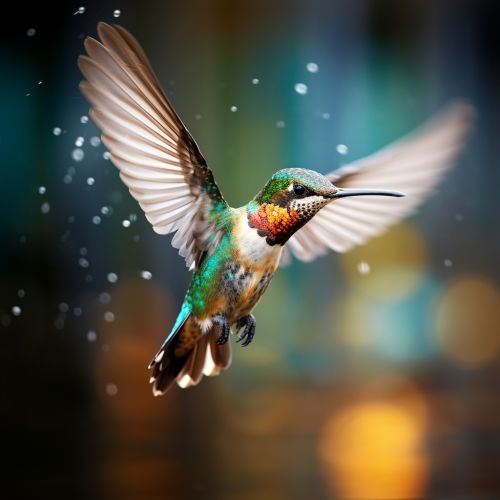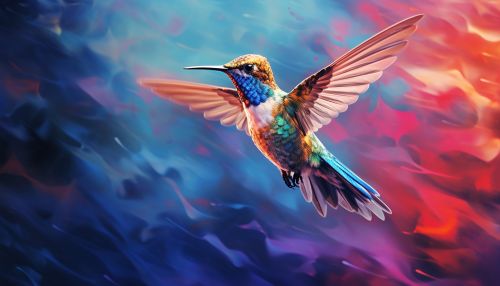Hummingbird
Taxonomy and Evolution
Hummingbirds are birds native to the Americas and constitute the biological family Trochilidae. They are among the smallest of birds, most species measuring 7.5–13 cm (3–5 in) in length. The smallest extant bird species is a hummingbird, the 5 cm (2.0 in) bee hummingbird. They are known for their ability to hover in mid-air by rapidly flapping their wings 12–80 times per second (depending on the species). Capable of sustained hovering, hummingbirds also have the ability to fly backward, being the only group of birds able to do so. Their English name derives from the characteristic hum made by their rapid wing beats.


Anatomy and Morphology
Hummingbirds have many physical characteristics that allow them to survive in diverse climates ranging from the tropical rainforests of South America to the cool climates of the Andes Mountains. They have compact, strongly muscled bodies and are among the smallest birds in the world. Their wings are unique among birds, possessing a full range of motion that allows them to fly forwards, backwards, and hover in place. The structure of their wings also allows them to beat their wings rapidly, creating the humming sound for which they are named.
Physiology
Hummingbirds have a high metabolic rate, with heart rates reaching over 1,200 beats per minute. They also have a high breathing rate, with an average of 250 breaths per minute, even at rest. Despite their high metabolism, hummingbirds have been known to enter a state of torpor to conserve energy. During torpor, the bird's body temperature and metabolic rate decrease significantly, allowing them to survive periods of food scarcity.
Diet and Feeding Behavior
Hummingbirds primarily feed on nectar, a sweet liquid inside certain flowers. They also consume small insects and spiders for protein and eat tree sap on occasion. Hummingbirds exhibit a unique method of feeding known as trap-lining, where they establish a pattern of feeding among a number of flowers in a specific order. This behavior allows them to maximize their energy intake by visiting flowers with the highest nectar production.
Reproduction
The reproductive habits of hummingbirds are diverse, with the majority of species being solitary nesters. The female is typically responsible for building the nest and raising the young alone. The nests, made from plant fibers, are often bound together with spider silk and camouflaged with lichen. The female typically lays two white eggs, which she incubates for 15 to 18 days.
Conservation
While some species of hummingbirds are widespread and common, others face threats to their survival. Habitat loss and fragmentation, climate change, and invasive species are among the main threats to hummingbird populations. Conservation efforts for hummingbirds include habitat restoration, establishment of protected areas, and public education about these unique birds.
Cultural Significance
In many cultures, hummingbirds have been seen as symbols of love, joy, and beauty. The Aztecs believed that hummingbirds were the reincarnation of warriors who died in battle. In Native American folklore, hummingbirds are often portrayed as healers or spirit beings that help people in need. Today, they continue to be popular in art, jewelry, and as symbols in logos and advertising.
